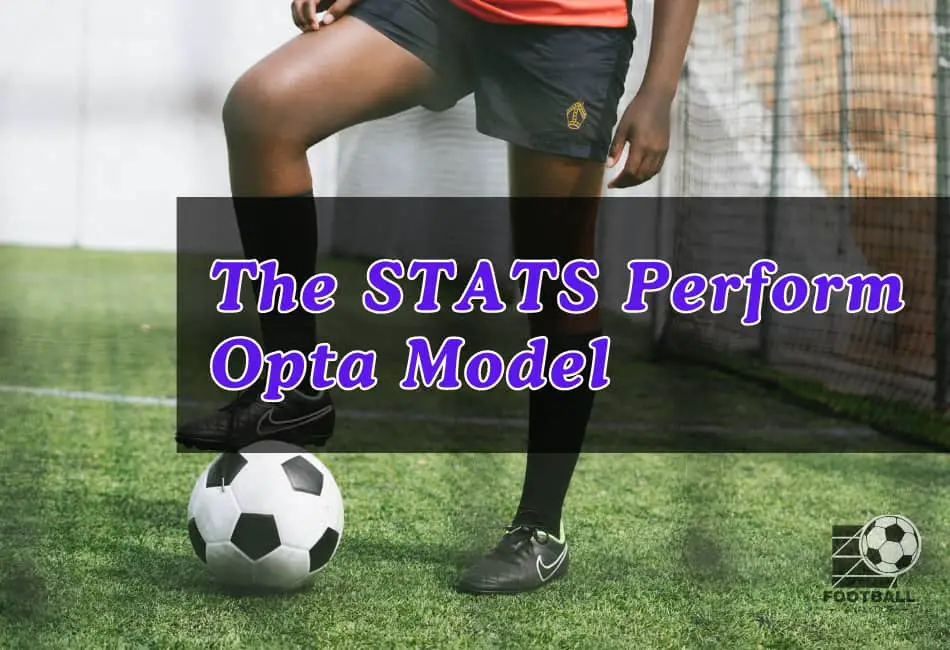As we’ve learned, Expected Goals (xG) is a vital metric in football analytics, helping to quantify the quality of scoring chances.
However, the effectiveness of xG as a tool largely depends on the model used to calculate it. Various xG models have been developed, each with its own methodology and variables.
In this section, we’ll dive into one of the most prominent xG models in the industry: the STATS Perform Opta xG model.
1. The STATS Perform Opta xG Model
The STATS Perform Opta xG model is one of the most widely recognized and used models in football analytics.
It is built using a logistic regression model, a statistical method that estimates the probability of a certain event occurring—in this case, the likelihood of a shot resulting in a goal.
This model is powered by hundreds of thousands of shots from historical OPTA data, making it incredibly robust and comprehensive.
The use of such a large dataset ensures that the model accounts for a wide range of scenarios and conditions, making its predictions reliable and accurate across different leagues and competitions.
2. Key Variables in the Opta xG Model
The STATS Perform Opta model considers several critical variables that affect the likelihood of a goal being scored. These variables include:
Distance to Goal: The closer the shot is to the goal, the higher the probability of scoring. The model accounts for this by assigning higher xG values to shots taken from within the box and lower values to those taken from further away.
Angle of the Shot: The angle at which the shot is taken relative to the goal is another key factor. Shots taken from central positions generally have a higher chance of success compared to those taken from tight angles.
One-on-One Situations: The model gives special consideration to one-on-one situations where a player is directly facing the goalkeeper. These situations typically have a higher probability of resulting in a goal due to the player’s clear scoring opportunity.
Body Part Used: Whether the shot is taken with the foot, head, or another body part can significantly influence the xG value. For example, foot shots usually have a higher success rate than headers, particularly when the ball is struck from a favorable position.
Type of Assist: The nature of the assist leading up to the shot also plays a role. A well-placed through ball or a perfectly timed cross can increase the likelihood of a goal, and the model accounts for these factors.
Pattern of Play: The context in which the shot is taken—whether it’s from open play, a counterattack, or a set piece—also impacts the xG value. Shots from well-structured plays are often more dangerous than those taken in disorganized situations.
3. How the Opta xG Model Works
The logistic regression model used by Opta estimates the probability of a goal by analyzing the aforementioned variables in each shot.
By feeding the model with a vast amount of historical data, it learns the relationships between these variables and the outcomes (goals or no goals).
The output is an xG value between 0 and 1 for each shot, indicating the probability that a shot will result in a goal. For example, if a shot has an xG value of 0.2, it suggests that similar shots would result in a goal 20% of the time.
4. The Impact and Use of the Opta xG Model
The Opta xG model is widely used by football clubs, analysts, and broadcasters to evaluate player and team performance.
It provides a more nuanced understanding of goal-scoring opportunities, helping teams to assess not just how many goals they scored, but how many they should have scored based on the quality of their chances.
This model is particularly valuable in scouting and recruitment, as it allows clubs to identify players who consistently outperform their xG, indicating a potential high level of skill or finishing ability.
Conversely, it can also identify players who underperform relative to their xG, suggesting areas for improvement or inefficiencies in their play.
Conclusion
The STATS Perform Opta xG model is a powerful tool in the world of football analytics, providing a sophisticated method for evaluating goal-scoring opportunities.
By leveraging a logistic regression model powered by an extensive historical dataset, it accounts for a wide range of variables that influence the likelihood of a goal.
This model not only enhances our understanding of the game but also aids in making more informed decisions in player evaluation, tactical planning, and overall team strategy.

